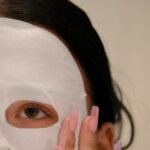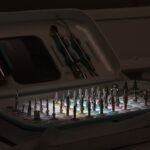Red light therapy (RLT) has emerged as a popular non-invasive treatment option in the realm of dermatology and wellness. This innovative therapy utilizes specific wavelengths of light, typically in the red and near-infrared spectrum, to stimulate cellular processes that promote healing and rejuvenation. The concept of using light for therapeutic purposes is not new; it dates back to ancient civilizations that recognized the healing properties of sunlight.
However, modern advancements in technology have allowed for a more targeted and effective application of this principle, leading to a resurgence of interest in red light therapy. The appeal of red light therapy lies in its versatility and the growing body of scientific evidence supporting its efficacy. From skin rejuvenation to pain relief, RLT has garnered attention for its potential benefits across various health and wellness domains.
As more individuals seek natural and holistic approaches to skincare and healing, red light therapy stands out as a promising option that aligns with these desires. This article delves into the mechanisms behind red light therapy, its specific applications for skin rejuvenation, and the myriad benefits it offers for various skin conditions.
Key Takeaways
- Red light therapy uses low-level red light to promote skin rejuvenation and healing.
- Red light therapy works by stimulating the production of collagen and elastin in the skin.
- The benefits of red light therapy for skin rejuvenation include improved skin tone, reduced wrinkles, and enhanced healing.
- Red light therapy can be effective for treating acne by reducing inflammation and promoting healing.
- Red light therapy can help reduce the appearance of wrinkles by stimulating collagen production and improving skin elasticity.
How Red Light Therapy Works for Skin Rejuvenation
At the core of red light therapy’s effectiveness is its ability to penetrate the skin at varying depths, depending on the wavelength used. Typically, wavelengths between 600 to 900 nanometers are employed, with red light (around 600-700 nm) primarily targeting the epidermis and near-infrared light (700-900 nm) reaching deeper layers such as the dermis. When these wavelengths are absorbed by the skin cells, they stimulate the mitochondria—the powerhouse of the cell—to produce more adenosine triphosphate (ATP).
This increase in ATP enhances cellular energy, promoting various biological processes essential for skin health. The stimulation of ATP production leads to several beneficial outcomes. For instance, it accelerates collagen synthesis, a crucial protein that provides structure and elasticity to the skin.
Collagen production naturally declines with age, contributing to wrinkles and sagging skin. By enhancing collagen levels, red light therapy can help restore a more youthful appearance. Additionally, RLT promotes improved blood circulation, which facilitates better nutrient delivery to skin cells and aids in the removal of toxins.
This dual action of boosting energy production and enhancing circulation creates an optimal environment for skin rejuvenation.
Benefits of Red Light Therapy for Skin Rejuvenation
The benefits of red light therapy for skin rejuvenation extend beyond mere aesthetics; they encompass a holistic approach to skin health. One of the most significant advantages is its ability to improve skin texture and tone. Regular sessions can lead to a more even complexion by reducing hyperpigmentation and promoting a healthy glow.
This is particularly beneficial for individuals dealing with sun damage or age spots, as RLT can help fade these imperfections over time. Moreover, red light therapy is known for its anti-inflammatory properties. By reducing inflammation in the skin, RLT can alleviate conditions such as rosacea or general redness, leading to a calmer and more balanced complexion.
The therapy also aids in minimizing pore size, which can enhance overall skin appearance. As a result, individuals often report smoother skin with fewer blemishes after consistent use of red light therapy devices. The cumulative effects of these benefits contribute to a more youthful and vibrant appearance, making RLT an appealing option for those seeking non-invasive skincare solutions.
Red Light Therapy for Acne Treatment
Acne is a prevalent skin condition that affects individuals of all ages, often leading to physical discomfort and emotional distress. Red light therapy has shown promise as an effective treatment modality for acne due to its ability to target the underlying causes of this condition. The anti-inflammatory properties of RLT help reduce redness and swelling associated with active breakouts, providing immediate relief for inflamed skin.
In addition to its anti-inflammatory effects, red light therapy also plays a role in regulating sebum production. Excess oil on the skin can contribute to clogged pores and subsequent acne formation. By promoting healthier skin cell turnover and reducing oiliness, RLT can help prevent future breakouts from occurring.
Furthermore, studies have indicated that RLT can reduce the presence of acne-causing bacteria on the skin’s surface, further enhancing its effectiveness as an acne treatment. As a result, many individuals have turned to red light therapy as a complementary approach to traditional acne treatments, finding it beneficial in managing their condition.
Red Light Therapy for Wrinkle Reduction
The quest for youthful skin often leads individuals to explore various anti-aging treatments, with red light therapy emerging as a frontrunner in this domain. One of the primary mechanisms through which RLT reduces wrinkles is by stimulating collagen production. As mentioned earlier, collagen is vital for maintaining skin elasticity and firmness; thus, increasing its levels can significantly diminish the appearance of fine lines and wrinkles.
Moreover, red light therapy enhances skin hydration by improving moisture retention within the dermal layers. Well-hydrated skin appears plumper and more resilient, which can further reduce the visibility of wrinkles. Additionally, RLT promotes cellular repair processes that combat oxidative stress—one of the key contributors to premature aging.
By mitigating oxidative damage caused by environmental factors such as UV exposure and pollution, red light therapy helps maintain a youthful complexion over time. Many users report noticeable improvements in their skin’s texture and elasticity after incorporating RLT into their skincare routine.
Red Light Therapy for Wound Healing
The application of red light therapy extends beyond cosmetic benefits; it has also been recognized for its remarkable ability to accelerate wound healing. When applied to injured or damaged skin, RLT stimulates cellular activity in the affected area, promoting faster tissue repair and regeneration. This is particularly beneficial for individuals recovering from surgical procedures or injuries.
Research has demonstrated that red light therapy can enhance fibroblast proliferation—the cells responsible for producing collagen and other extracellular matrix components essential for wound healing. By increasing fibroblast activity, RLT not only speeds up the healing process but also improves the quality of scar tissue formed during recovery. Additionally, RLT’s anti-inflammatory properties help reduce swelling and discomfort associated with wounds, creating a more conducive environment for healing.
As a result, many healthcare professionals are incorporating red light therapy into post-operative care protocols to optimize recovery outcomes.
Red Light Therapy for Scar Reduction
Scarring is a common concern following injuries or surgeries, often leading individuals to seek effective treatments for scar reduction. Red light therapy has gained recognition as a viable option for minimizing the appearance of scars due to its ability to promote collagen remodeling and enhance tissue regeneration. When applied to scarred areas, RLT stimulates fibroblast activity, encouraging the production of new collagen fibers that can help smooth out uneven textures.
Furthermore, red light therapy aids in reducing hyperpigmentation associated with scars by promoting even skin tone through increased blood circulation and cellular turnover. This dual action not only helps flatten raised scars but also diminishes discoloration over time. Many individuals have reported significant improvements in their scars’ appearance after consistent use of RLT devices, making it an appealing choice for those looking to enhance their skin’s overall texture and tone.
Red Light Therapy for Psoriasis and Eczema
Chronic skin conditions such as psoriasis and eczema can be challenging to manage due to their inflammatory nature and tendency to flare up unpredictably. Red light therapy offers a promising adjunctive treatment option for individuals suffering from these conditions by targeting inflammation at its source. The anti-inflammatory effects of RLT can help alleviate redness, itching, and discomfort associated with flare-ups.
In addition to reducing inflammation, red light therapy promotes healing within the affected areas by enhancing cellular turnover and improving blood flow. This can lead to faster resolution of lesions and patches associated with psoriasis or eczema. Some studies have indicated that patients using RLT report fewer flare-ups and improved overall skin health when incorporated into their treatment regimen.
As such, many dermatologists are beginning to recommend red light therapy as part of a comprehensive approach to managing chronic inflammatory skin conditions.
Red Light Therapy for Rosacea Treatment
Rosacea is a chronic inflammatory condition characterized by facial redness, visible blood vessels, and sometimes acne-like breakouts. The unpredictable nature of rosacea can be frustrating for those affected; however, red light therapy presents a potential solution by addressing inflammation directly. The soothing effects of RLT can help calm irritated skin while reducing redness associated with rosacea flare-ups.
Moreover, red light therapy promotes improved circulation within the skin, which can aid in reducing the appearance of visible blood vessels over time. By enhancing overall skin health through increased collagen production and cellular repair processes, RLT may contribute to long-term improvements in rosacea symptoms. Many individuals have found relief from their rosacea symptoms through regular use of red light therapy devices, making it an increasingly popular choice among those seeking effective management strategies.
Red Light Therapy for Sun Damage Repair
Sun exposure is one of the leading causes of premature aging and skin damage, resulting in issues such as fine lines, wrinkles, hyperpigmentation, and uneven texture. Red light therapy offers a multifaceted approach to repairing sun-damaged skin by stimulating cellular repair processes while promoting collagen synthesis. This dual action helps restore elasticity and firmness while addressing discoloration caused by UV exposure.
Additionally, RLT enhances blood flow within the skin, facilitating better nutrient delivery essential for repair processes. Over time, individuals using red light therapy have reported improvements in their overall complexion as sunspots fade and skin texture becomes smoother. The ability of RLT to mitigate some effects of sun damage makes it an attractive option for those looking to rejuvenate their skin after years of sun exposure.
Conclusion and Considerations for Red Light Therapy
As interest in red light therapy continues to grow within both clinical settings and at-home skincare routines, it is essential for individuals considering this treatment to understand its potential benefits as well as any limitations or considerations involved. While many users report positive outcomes from RLT across various applications—from acne treatment to wrinkle reduction—results can vary based on individual factors such as skin type and condition severity. It is advisable for individuals interested in incorporating red light therapy into their skincare regimen to consult with a qualified healthcare professional or dermatologist who can provide personalized recommendations based on their unique needs.
Additionally, understanding proper usage guidelines—such as duration and frequency of sessions—can optimize results while minimizing any potential side effects. With ongoing research supporting its efficacy and safety profile, red light therapy stands poised as a valuable tool in modern skincare practices.









